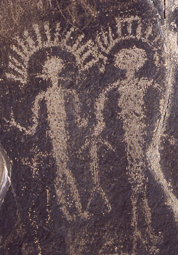Ethnography, shamanism, and Far Western North American rock art
Etnografía, chamanismo y arte rupestre del Lejano Oeste norteamericano
Far Western North America has a very detailed ethnographic record which includes significant details about shamanism and its relationship to rock art. The ethnographic evidence from three culture areas (Californian, Great Basin, and Columbia-Fraser Plateau) is summarized here. This shows widespread ties between the art and portrayals of visionary experiences, believed to be signs of the acquisition of supernatural power. The ethnography also demonstrates substantial differences in the origins of the art, especially in terms of the social groups and rituals responsible for its creation as well as its relationship to mythology. The ethnography further illustrates the fact that different styles of rock art were sometimes created by different social groups for different functions within the same culture and time period. Shamanism, in this sense, is a context within which rock art may be analyzed and interpreted, but not a final explanation for its presence.
Keywords: rock art, shamanism, ethnography, Far Western North America, symbolic interpretation.
INTRODUCTION
Few regions globally have more rock art than Far Western North America, which includes portions of the Californian, Great Basin, and Columbia-Fraser Plateau culture areas (fig. 1). In the Californian culture area, for example, the San Andreas earthquake rift zone has a renowned concentration of Chumash pictographs, while the Colorado River corridor has numerous geoglyphs and petroglyphs. Rock engravings are especially common in the Great Basin culture area, which includes the Coso Mountains, alone estimated to contain over a million individual petroglyphs. Pictographs and petroglyphs are both found in the Columbia-Fraser Plateau culture area, in contrast, with a major concentration present along the Columbia River.

Figure 1. Culture areas of North America, as defined by Kroeber (1939). The ethnographic record about rock art is especially detailed for three of these areas discussed in this paper: California, Great Basin, and Columbia-Fraser Plateau. Figura 1. Áreas culturales de América del Norte, según la definición de Kroeber (1939). El registro etnográfico de arte rupestre es especialmente detallado para tres de estas áreas, discutidas en este artículo: California, la Gran Cuenca y la meseta Columbia-Fraser.
Despite comprising three distinct culture areas (Kroeber 1939), Far Western North America is similar in five ways. First, it was occupied by hunters-gatherers (including, in some areas, hunters-gatherers-fishers). Second, Euro-American contact was relatively recent across this wide region, starting in the late 18th century in coastal California but only occurring in the mid- to late 19th century in other areas. Third, the result is widespread cultural continuity: many tribal groups, for example, still include speakers of their Indigenous languages who retain traditional beliefs. Fourth, Alfred Kroeber (1925) and his students initiated a significant salvage ethnographic program in this region in the early 20th century. This produced one of the largest and most complete hunter-gatherer ethnographic records in the world. One outcome of this research is perhaps our best ethnographic record on the making and meaning of hunter-gatherer rock art. Fifth, throughout Far Western North America the ethnography links this rock art to shamanistic ritual practices, an unsurprising circumstance given that the rock art in this region was tied to religious beliefs, and these religions were shamanistic (Kroeber 1907, 1925; Gayton 1930; Park 1938; Stewart 1970).
In his global synthesis Mircea Eliade (1964) emphasized the centrality of altered states of consciousness (hereafter asc), specifically “ecstatic” visions, to shamanism and its rituals, effectively defining shamans in phenomenological terms as experts in achieving ecstatic states. Shirokogoroff (1935) and Firth (1959), in contrast, labeled shamans as “masters of the spirits,” thus foregrounding metaphysical beliefs. These distinctions are differences in emphasis rather than kind, however, with general consensus recognizing both the significance of asc and the connections to supernatural spirits as central to shamanistic religions.
Following Taçon (1983), I define shamanistic as of or pertaining to the beliefs and practices associated with shamanism. Shamanism itself is a religious system predicated on perceived direct interactions with the supernatural world, typically achieved through asc –as the anthropological saying goes, priests talk to gods whereas the gods talk to shamans. Shamans, then, were ritual officials in shamanistic religions while shamanic refers specifically and is limited to the rituals and actions of a shaman, per se. In the Far West, shamans were the primary –often the only– ritual officials. While there were shamanic specialties involving particular supernatural powers (such as weather control or sorcery), shamans were generally considered healers and, in an English gloss, are referred to as “doctors” in much of the anthropological literature. As Laird (1984) has made clear, however, shamans were curers only in the social-psychological sense; their expertise did not necessarily involve botanical-pharmacological knowledge or other curing for medical illnesses. Instead, it concerned perceived psychic or social imbalances.
As described below, rock art in the Far West includes examples that are shamanic (made by shamans alone) and shamanistic (made by non-shamans but following shamanistic beliefs and practices), although not all cultures or culture areas necessarily had both kinds. With only one exception, however, all Far Western shamanic and shamanistic rock art was linked to asc. Based on the regional ethnographic accounts, no other origins for rock art have been described or can be inferred.
Despite Eliade’s (1964) emphasis on “ecstatic” asc, furthermore, shamanistic states of consciousness in the Far West were in fact rarely ecstatic, in the common sense of this word, or even pleasant. More typically they were closer to nightmares or “bad trips,” as adverse hallucinatory experiences were labeled in 1960s Western cultures (Whitley 2009). One result is that shamanic rock art usually resulted from individual experiences involving asc induced by fasting, extreme physical exertion, isolation, sensory deprivation, and/or the consumption of tobacco (Nicotiana spp.), which in its native form is hallucinogenic (Wilbert 1987). Shamanistic rock art, in contrast, sometimes resulted from group rituals where more dangerous and unpredictable hallucinogens, especially jimsonweed (Datura wrightii), were ingested and where ritual initiates were necessarily overseen by care-givers. Non-ritual and non-shamanic uses of both tobacco and jimsonweed also sometimes occurred (Kroeber 1925), typically for self-healing purposes but, based on the ethnographic accounts, these apparently did not result in the creation of rock art.
Shamanistic interpretations of hunter-gatherer rock art have been common worldwide since at least the 1980s (Lewis-Williams 1981; Lewis-Williams & Dowson 1988; Whitley 1992; Francis & Loendorf 2002; Keyser & Taylor 2002; Rozwadowski & Kosko 2002). Perhaps because they have become so common, these interpretations have been criticized for being monolithic, putatively homogenizing all hunter-gatherer rock art into a single, one-size fits all explanation that erases temporal, geographical, and cultural variability (Jones 2017). This criticism, in fact, is itself a monolithic meta-interpretation of this research rather than an accurate reflection of the variability in these shamanistic studies. It collapses interpretations that have highlighted the differences in the making and meaning of rock art, even within the framework of the broad category of shamanistic religions (Whitley 2000, 2014a, 2021), into one unitary model. It is little different than mistakenly claiming that the classification of Christianity, Judaism, and Islam into the single category of Abrahamic religions requires ignoring all variability in the beliefs and practices of these three religions.
Far Western North American rock art provides an excellent case study of the variability in the making and meaning of shamanistic hunter-gatherer rock art. I provide an overview of the rock art ethnography, primarily based on a compilation and synthesis of published and unpublished ethnographic accounts, of this broad region below. Note that the ethnographic record dates to the ninetheenth and twentieth centuries but in all cases it represents an effort to reconstruct traditional Indigenous lifeways as they were most likely practiced at the time of Euro-American contact (which occurred from the late eighteenth to mid-nineteenth centuries, depending on region). Note further that certain traditional cultural practices continued, effectively unchanged, into at least the mid-twentieth century. Religious beliefs and rituals are key among these. As Julian Steward (1955: 58) observed, a century of contact
[…] has not wiped out all Indian practices. Acculturation has consisted primarily of modifications of those patterns necessary to adjust to rural white culture […]. The Shoshoni retain, however, many practices and beliefs pertaining to kinship relations, child-rearing, shamanism, supernatural power and magic.
Similarly, Raymond White (1963: 135) noted,
That religion frequently shows great resistance to change and is deeply involved in the social structure as well as the psychological patterns of a culture has been repeatedly demonstrated in anthropology. This is also true for the Luiseño. A rich body of the central characteristics of the old native religion has persisted in spite of missionary influences for nearly two centuries […]. Many features of the old Luiseño culture have been preserved.
Multiple examples support continuity in rock art rituals specifically throughout the ethnographic/historic period. To cite just one example, the ethnographic accounts provided by the Okanagan informant Annie York in the early 1990s (York et al. 1993) very closely parallel the independent descriptions of Columbia-Fraser Plateau puberty initiation and shamanic rock art recorded by Teit (1896, 1930, n.d.) and Hill-Tout (1978) fully a century earlier. While archaeological interpretations of rock art have changed a number of times over the lifespan of the discipline, Native Americans have been consistent in their statements about the origin and meaning of the art, signaling the continuity in their religious practices.
The ethnographic synthesis presented here can then be understood as relevant to the post-Euro-American contact period, which began in ad 1773 on the coast. In certain cases, the traditional practices described below continue into contemporary times.(1) But the synthesis also generally applies to the Late Prehistoric period (ad 1200 to contact) in this portion of California, given that there was a substantial continuity between pre-contact lifeways and those described by ethnographic informants.
This ethnography highlights the distinctions in the individuals and groups responsible for making the art, the variety of rituals that resulted in its creation, and the differing uses and meanings of this art. It also illustrates an important fact about the significance of different descriptive rock art “styles.” The variations of shamanic and shamanistic rock art described here may provide useful models –or at least starting hypotheses– for the analysis and interpretation of hunter-gatherer rock art in South America, if not also in other parts of the world. I start, however, with some methodological comments on ethnographic and symbolic interpretations involving fundamental principles that are often unrecognized or misunderstood by researchers.
PRINCIPLES OF ETHNOGRAPHIC AND SYMBOLIC INTERPRETATION
Archaeologists worldwide have often claimed that ethnographic interpretations of rock art are impossible, because there is no or very little information about rock art in the ethnographic record. Certainly, there are regions where no rock art ethnography exists or that, due to the age of the art, could not possibly exist, and the presence or absence of such information must be evaluated on a region-by-region basis. But too often this claim has resulted not from an absence of ethnographic data but from both a failure to understand how ethnographic research must be conducted and a simple lack of effort. Five principles provide the starting point for studies of rock art ethnography.
First, ethnographic data are always “raw data,” not final answers, that themselves must be collected, analyzed, and interpreted (Radcliffe-Brown 1922; Sperber 1975; Layton 2001). Ethnographic research is a search for evidence, just like archaeological fieldwork, not for immediate conclusions and quick answers. Ethnographic rock art interpretations are developed from detailed study involving multiple lines of evidence, not from single sensational discoveries.
Second, most Indigenous peoples have ontological and epistemological beliefs that are very different from our Western Enlightenment worldview. Ethnographic commentary, accordingly, can only be understood in Indigenous rather than Western ontological terms (Layton 1992: 13). For example, Heizer and Baumhoff (1962) recognized that some Native Americans attributed the origins of the art to small spirits (Voegelin 1938; Laird 1976, 1984; Zigmond 1977, 1986; Irwin 1980; Hultkrantz 1987; Stoffle et al. 2011a, 2011b), but argued that this demonstrated a lack of any direct knowledge of the art, because such a belief is empirically absurd from a Western scientific perspective. Based on this conclusion they argued that the art therefore must pre-date the contemporary inhabitants of this region. But these small spirits, understood in appropriate ontological context, are shamans’ spirit helpers, and the actions of a shaman and his helpers were considered indistinguishable (Gayton 1948; Applegate 1978; Siskin 1983; Laird 1984). To state that the art was made by these spirits was an appropriate way of acknowledging that rock art was made by a shaman without violating the taboo against naming the dead (Whitley 2000, 2012, 2021).
Third, we can cautiously use ethnographic data to interpret the prehistoric past using the direct historical approach (Marcus & Flannery 1994). Critics argue that this simply projects recent ethnography onto the distant past. While specific studies potentially could be guilty of this error, it is not a general methodological problem for the approach. Prehistorians should be able to identify change over time in the archaeological record, and to determine when the direct historical approach is appropriate and when change renders it no longer useful (Whitley 2020). Properly applied, the direct historical approach is one of the most useful analytical methods in archaeology, and it has the strong advantage of helping avoid presentist biases in our interpretation.
Fourth, many symbolic systems are empirically-based, even if this is not immediately evident to modern, urban-dwelling scientists who are largely unfamiliar with the natural world of Indigenous peoples. Rather than arbitrary, symbols are often based on natural models:
These are natural phenomena, like animal behavior, that served to structure the logic underlying aspects of religious symbolism and ritual, usually by some form of analogical reasoning. In this sense, the thought underlying these models is rational and systematic. When natural models are based on phenomena that themselves involve invariant principles, uniformitarian laws, or timeless characteristics, the models have the potential to inform our understanding of truly prehistoric religious phenomena, without benefit of informants’ exegesis, and sometimes even without ethnohistorical connections (Whitley 2001: 132-133).
Lewis-Williams and Dowson’s (1988) neuropsychological model for the mental imagery generated by an asc experience is perhaps the best known and most widely applied natural model. It strictly concerns the origin but not necessarily the meaning of motifs. It includes both initially-perceived geometric light imagery, known as entopic patterns, as well as iconic images (many but not all of which are unrealistic in terms of our natural world), and the different ways that these images may be perceived. Because this imagery is based on the hardwiring of our neuropsychological systems, it is universal. Because of the centrality of asc in shamanistic ritual and symbolism, combinations of these different graphic characteristics in art provide strong support for a shamanistic interpretation of the art.
The bodily and emotional reactions to an asc are also important natural models for shamanic symbolism. Such experiences, which combine intense emotions with strong bodily reactions and feelings, are very difficult to describe. The solution to this problem, common among North- and South-American Native Americans, Siberian and African shamans, and contemporary Western laboratory subjects and recreational drug-users, is to use a set of cross-culturally shared, embodied metaphors. The most common of these, as described in different cultural contexts and settings, are: death/killing/aggression/drowning/fighting/“bummer trip”; mystical flight/out of body experience/trip; bodily transformation/change; and sexual arousal/intercourse (Whitley 1994a, 2001, 2008, 2023). Iconic imagery depicting these themes may also support a shamanistic interpretation of a corpus of art. Strong support for such an interpretation results when the asc metaphors are combined with entoptic patterns.
A final and likewise important category of natural models in hunter-gatherer symbolism involves the behavioral traits of animals. These may have no necessary direct relationship to shamanism or asc. They often reflect a level of knowledge about the natural world that is absent in modern, urbanized Westerners. We frequently use these kinds of natural models in our own symbolism ‒such as the “Lions” as a name for a sports team, for example, reflecting the idea that these are fearless, dominant animals, and projecting those characteristics onto the team. I provide one detailed example of such a model, based on the behavioral patterns of bighorn sheep, below.
Fifth, all symbols have multiple meanings and uses (Sharp 1987; Lewis-Williams 1998). While the origin of a rock art motif resulted from a specific ritual with a particular intent, its meaning and significance could vary depending upon the viewer, their relationship to the creator, their level of cultural knowledge, and their interest or need. Rock art motifs commonly served a secondary function for education, even if informal, and as a focus of group and individual self-identity, for example. In addition, rock art sites in Far Western North America commonly are places for prayer, supplication, and spiritual curing (Stoffle et al. 2011a, 2011b). This partly reflects their perceived origin, with rock art marking the locations as places of spiritual revelation, but also the variable nature of the way the symbols and places were understood and used (Whitley & Whitley 2012).
One final methodological issue warrants mention. Some archaeologists claim that rock art interpretations are impossible without a direct explanation from the artist, because only the artist knows what their painting or engraving means. This is confused on a couple of points. Rock art is a form of communication that, unlike a performance such as a dance or song, is intended to persist, and to relay a message, even in the absence of the artist. The fundamental purpose of rock art then is to communicate information independent of its creator. Otherwise, why bother to make it? Moreover, rock art motifs comprise components of an iconographic corpus or system. These are specific sets of symbols with culturally-shared meanings. Regional rock art corpora then can be classified using a motif typology. Typologies demonstrate that there is repetition and patterning in the motifs, often including patterning in motif associations, all of which are characteristic of shared systems of meaning and communication (Whitley 2001).
Certainly, there may be occasional, isolated examples of rock art that are entirely unique and, lacking any context or comparability, cannot be interpreted. But such anecdotal examples would be the rare exceptions that have no implications for the more common cases of regionally patterned iconographic corpora. Similarly, there are levels of an artist’s personal intentions that we may not be able to recover. But this too has no implications for the interpretation of rock art at the level of cultural-shared meanings.
The discussion below provides a summary of interpretations of Far Western rock art, based on an analysis of existing ethnographic accounts using the methodological principles described above. This emphasizes the origin or creation of the art and its primary meanings to the artists rather than its potential secondary meanings or uses.
CALIFORNIAN ROCK ART
The Native Californian culture area was a socially diverse region with between 60 to 80 mutually unintelligible languages and hunter-gatherer-fisher population densities that, in some areas, rivaled those of horticulturalists (Kroeber 1925). Although there are occasional examples further north, most rock art in this region occurs south of the San Francisco Bay (Whitley 2000). The large majority of this art is painted, with significant concentrations in southwestern California (in the San Diego region), along the central coast (inland from Santa Barbara), and in the southern Sierra Nevada. Another important concentration is located along the Colorado River corridor, the eastern limit of the region. A comparison of the rock art from the southwest, south-central (combining the central coast and Sierra Nevada), and Colorado River areas of Native California provides a useful understanding of the nature and variability of shamanistic rock art in Native California. The following descriptions summarize ethnographic data and interpretations for this large region.
Southwestern California
Southwestern California includes coastal California from Los Angeles to the Mexican border and adjacent inland areas and mountains extending to the eastern deserts. It was primarily occupied by Takic (e.g., Luiseño) and Yuman (e.g., Ipai-Tipai) speakers. Pictographs were created in two contexts by three social groups in southwestern California (Whitley 1992, 2000, 2006). In each case the art was associated with asc. The intent of such experiences, throughout Far Western North America, was to receive spiritual power, manifest in spirit helpers, and to manipulate this power for both positive and evil purposes. All people had a certain amount of this potency, and it was required for success in all aspects of life. Shamans differed from non-shamans in having more spirit helpers and greater quantities of power which they could use for a variety of purposes (Bean 1975). asc experiences were induced through fasting, isolation/sensory deprivation, extreme exertion, and the use of hallucinogens including jimsonweed (D. wrightii), native tobacco (usually swallowed), and ingesting red ants in eagle-feather down balls, which resulted in the hallucination-causing injection of formic acid in the stomach lining by the biting ants (Kroeber 1925).
Southwestern California shamans painted panels with a wide variety of (primarily) geometric patterns, often on boulders located near their villages (fig. 2) (Whitley 2000). These designs originated in the entoptic patterns generated within the eye during an asc (Lewis-Williams & Dowson 1988), which occurred during shamans’ vision quests as well as during their subsequent efforts to employ supernatural power. For example:
According to Lowie […] during a vision quest a shaman “sees a light, which represents the expected medicine power [i.e., supernatural spirit] […]. In the night, his medicine speaks to him and counsels him. It may tell him how he ought to paint” (1909: 223-224). Hultkrantz likewise stated that “The puha [supernatural power] approaches you like a strong light” (1987: 54). Descriptions of shamans’ asc mental imagery […] include additional geometric light images such as fire, sparks, circular patterns like baskets, and stars (Latta 1976) (Whitley 2023).
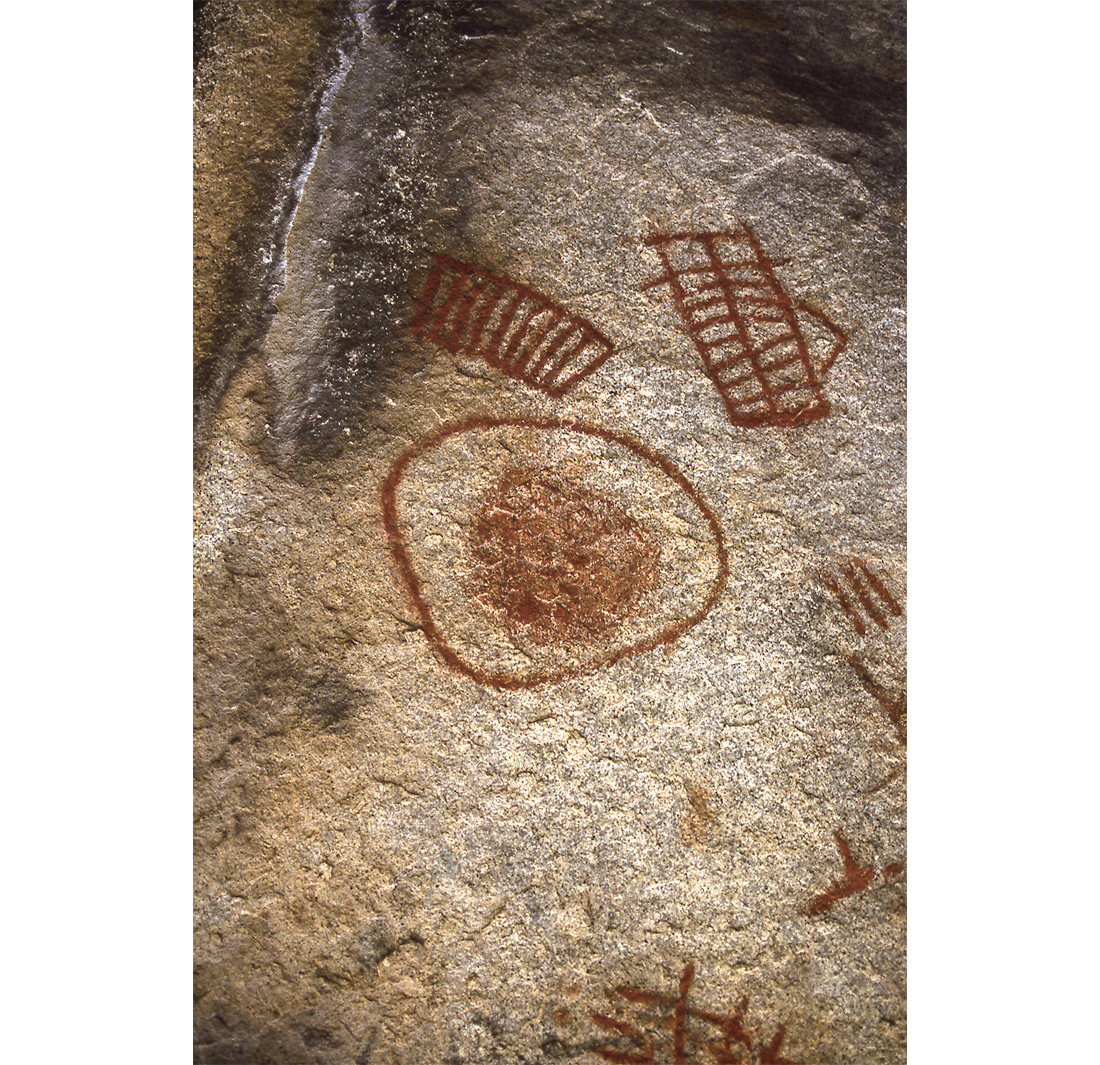
Figure 2. Southwestern California rock art includes sites made by shamans and by girls and boys during their puberty initiations. This site, Echo Rock, appears to have been made by one or more shamans, and it depicts the geometric/entoptic images seen in a trance. Size of central circle motif: about 30 cm (all photos by the author with the exception of figure 10). Figura 2. El arte rupestre del suroeste de California incluye sitios pintados por chamanes así como por niñas y niños durante sus iniciaciones a la pubertad. Este sitio, Echo Rock, parece haber sido hecho por uno o más chamanes y representa imágenes geométricas/entópticas vistas durante un trance. Tamaño del motivo circular central: cerca de 30 cm (todas las fotografías son del autor, excepto la de la figura 10).
These Far Western ethnographic accounts correlate with the Lewis-Williams and Dowson (1988) model of the geometric mental images generated in an asc as well as with the rock art motifs themselves, and they demonstrate that the perceptions of these geometric patterns were understood as the receipt of supernatural spirit power.
Boys and girls also painted motifs at the culmination of their respective puberty initiations (DuBois 1908; Hooper 1920; Kroeber 1925; Steward 1929; Strong 1929; Driver 1941; True 1954; Whitley 2006). Although little is known about the boys’ initiation, the evidence suggests that they created black geometric paintings (Oxendine 1980). The girls’ ritual, in contrast, is very well documented, with the last known initiation occurring in 1895 (fig. 3) (True & Griset 1988). Girls painted red motifs as the final event in their rites to depict the spirit helper they had received during their ceremonial isolation. The ideal girls’ helper, in a symbolic inversion, was the rattlesnake, the guardian of the female vagina. Rattlesnake spirits were depicted in two stylized fashions, reflecting similar natural models: diamond chains, representing the scale pattern on the back of the diamondback rattlesnakes; and zigzags, the pattern left in the sand by a moving sidewinder rattlesnake (Whitley 1992, 2000, 2006).
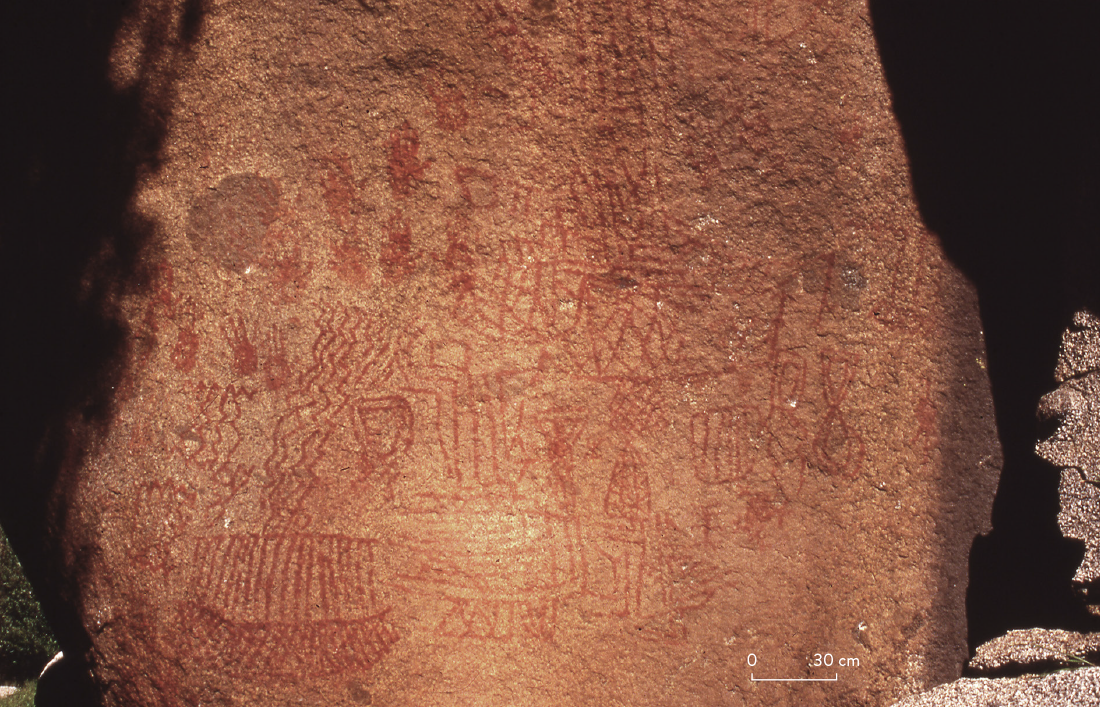
Figure 3. Girls puberty initiations are very well documented in southwestern California. Zigzags and diamond chains, both representing rattlesnake spirits, and hand-prints are the most common motifs. This site is known as Puberty Rock. Figura 3. Las iniciaciones de pubertad de niñas están muy bien documentadas en el suroeste de California. Cadenas de diamantes y motivos de zigzag, ambos representando espíritus de serpientes cascabel, junto con impresiones de manos son los motivos más comunes. Este sitio es conocido como Puberty Rock.
Note an important point, emphasized further below: two descriptive “styles” of rock art were then created in southwestern California by different social groups, in different ritual contexts, during the same time period: shamans’ and puberty initiates’ art. These two rock art varieties can be understood as functional styles. Yet both styles reflect related beliefs and concerns.
South-central California
South-central California rock art includes the renowned Chumash paintings in the inland Santa Barbara region as well as an even larger concentration of Yokuts and Mono art in the southern Sierra Nevada. Although there are a few intriguing examples that suggest that puberty initiates may have occasionally made rock art in this region, the vast majority of the paintings was created by shamans to show their spirit helpers, themselves transformed, and/or their manipulation of power. As Driver (1937: 126; internal quotes in original) noted, shamans, “painted their ‘spirits’ (anit) on rocks to ‘show themselves, to let people see what they had done. The spirit must come first in a dream’” (see also Gayton 1930, 1948; Aginsky 1943). Driver’s reference to “dream” here represents a widely used ethnographic gloss for asc (Kroeber 1907, 1925; Bean 1975).
Figure 4, a psychedelic polychrome from Chumash territory, is in fact an anthropomorph with head, torso, and arms repeatedly “exploding” though the shoulders, most likely illustrating the sensation of a rush of energy that accompanies some ascs. Figure 5, from Yokuts territory in the southern Sierra Nevada in contrast, is described by a contemporary informant (a descendant of the painter) as a “bridge to the supernatural” and a “shaman’s dream” (reflecting the gloss for an asc) (Whitley 2000: 74-75).
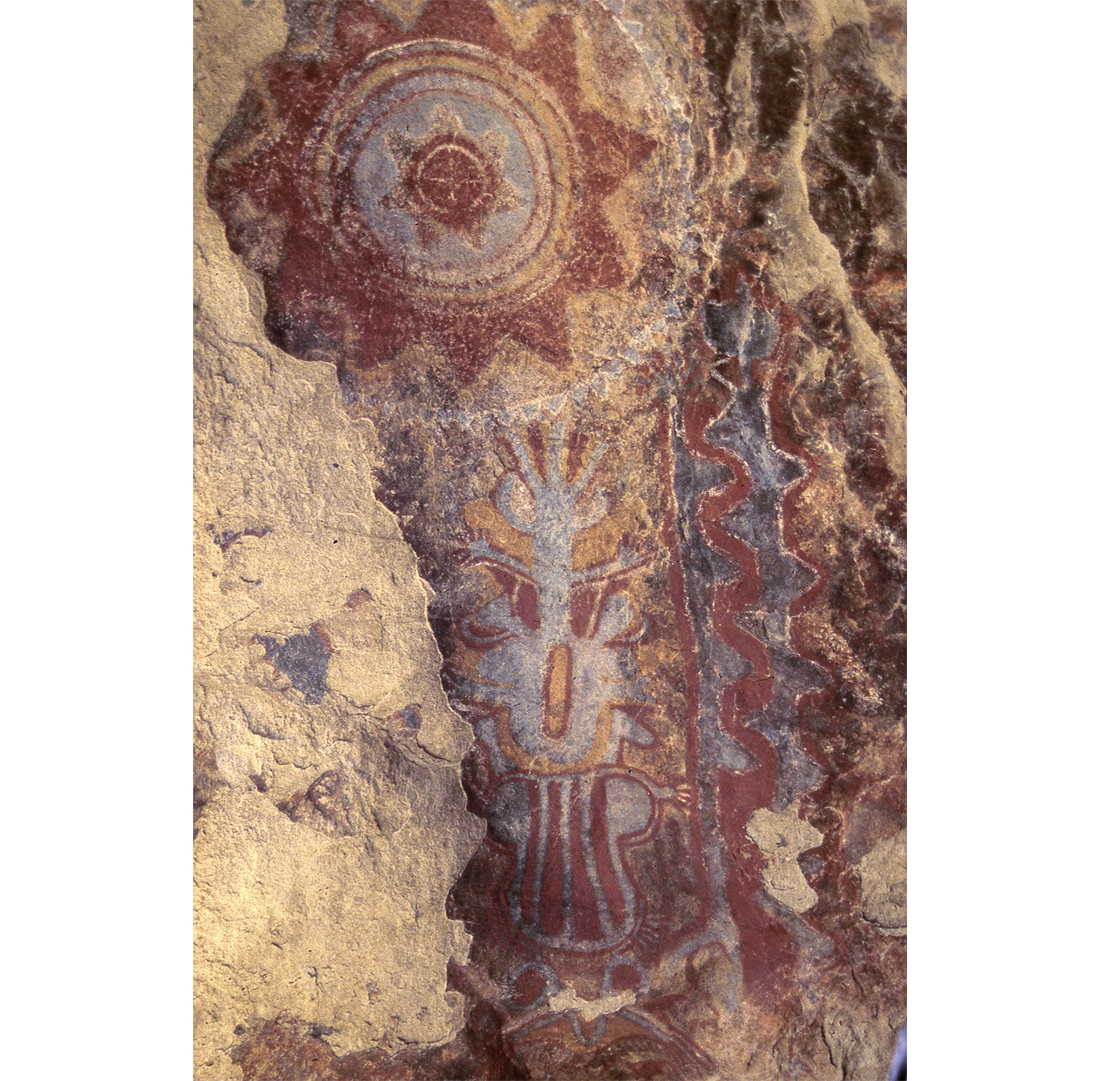
Figure 4. Chumash pictographs, from south-central California, include spectacular bi-chromes and polychromes. The large, central vertical motif on this panel (immediately to the right of the exfoliated area), from the Pleito Creek site, depicts an anthropomorph with an exploding torso; note the small arms, hands, and fingers that are portrayed extending outwards on the bottom and central torsos. A mandala-like motif is immediately above while a zigzag/rattlesnake motif is present to the right. Length of central motif: about 50 cm. Figura 4. Las pictografías chumash, del centro sur de California, incluyen bicromías y policromías espectaculares. El gran motivo vertical central en este panel (inmediatamente a la derecha del área exfoliada) del sitio de Pleito Creek, representa un antropomorfo con un torso explotando. Nótense los brazos pequeños, manos y dedos que son representados extendiéndose hacia afuera en la parte inferior y central del torso. Inmediatamente arriba hay un motivo como de mandala y a la derecha se representa un motivo de zigzag/serpiente de cascabel. Longitud del motivo central: cerca de 50 cm.

Figure 5. Some contemporary tribal members are descendants of the painters of Yokuts rock art in the southern Sierra Nevada of south-central California. This panel, from the Rocky Hill site, is described both as a “shaman’s dream” and as a “bridge to the supernatural” (Whitley 2000: 74-75). The red horned anthropomorph towards the bottom left is described as Wehesit, a dangerous/evil spirit sometimes seen in the supernatural world. Length of the series of enclosed white parallel lines: about 75 cm. Figura 5. Algunos miembros de las tribus contemporáneas son descendientes de los pintores del arte rupestre yokuts en la sureña Sierra Nevada del centro sur de California. Este panel, del sitio de Rocky Hill, es descrito a la vez como “un sueño de chamán” y como un “puente a lo sobrenatural”. El antropomorfo con cuernos rojos hacia la parte inferior izquierda es descrito como un Wehesit, un espíritu peligroso/maligno, visto a veces en el mundo sobrenatural. Longitud de la serie de líneas paralelas blancas encerradas: cerca de 75 cm.
South-central California pictograph sites are located adjacent to villages. They were known generically as “shaman’s caches,” where shamans putatively stored their ritual paraphernalia inside the rocks, which were said to open at their command, indicated that the one entered the supernatural realm by traveling into these rocks (Gayton 1930, 1948). The sites were painted after a four-day vision quest, away from the habitations, specifically to illustrate the shamans’ visionary experiences and manipulations of supernatural power. Portrayals of spirit helpers and shamans transformed into their supernatural form (fig. 4) are common. So are geometric patterns, originating in the entoptic images of trance (fig. 5). But some panels also depict acts of sorcery, based on an identification by a contemporary Yokuts informant (fig. 6). This circumstance itself reflects the nature of supernatural power, which could be used for healing or to inflict disease (Whiting 1950; Bean 1975; Miller 1983). Shamans and also rock art sites were then potentially dangerous, with the sites “avoided,” in the anthropological sense of this term; that is, they were treated carefully, with respect and supplication (Zigmond 1977), much as a husband could never talk directly to his mother-in-law even if they lived in the same hut. The placement of rock art sites within villages emphasized and reinforced the power of the shaman in tribal society.
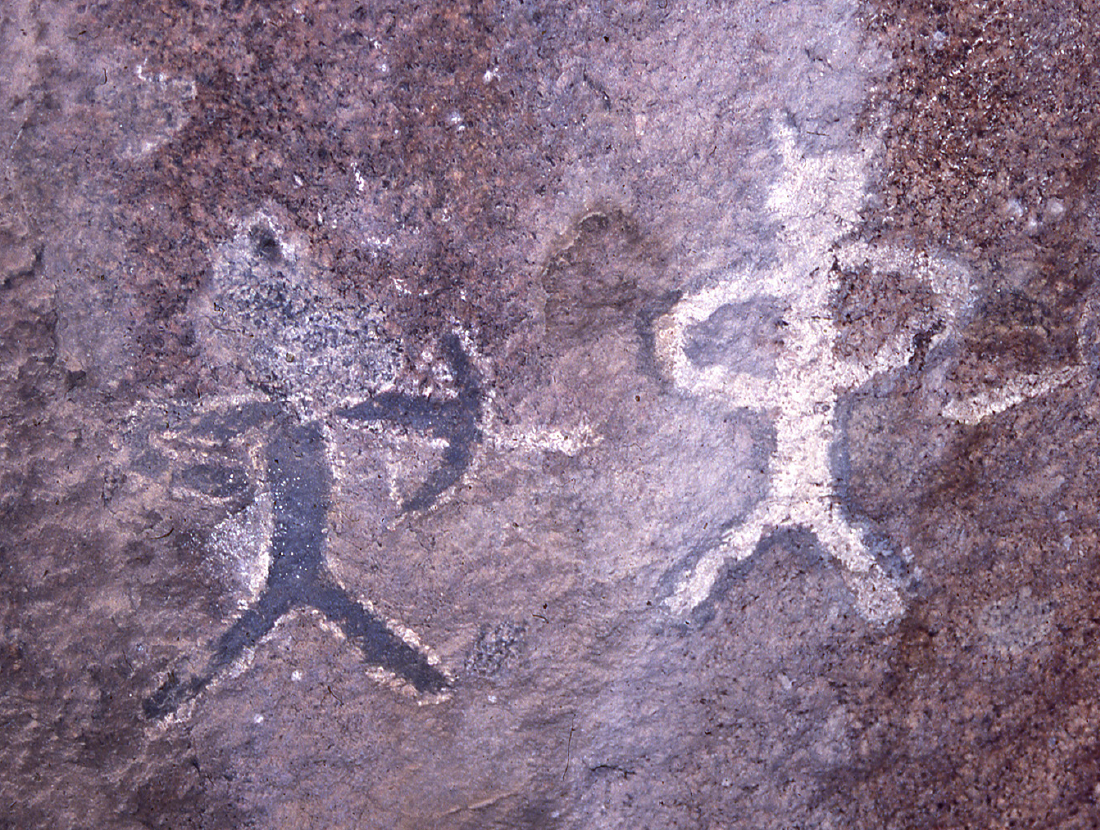
Figure 6. Shamans created rock art both to portray their acquisition of power, and in the rituals where they manipulated their power. These two anthropomorphs, at the Rocky Hill site, are described as an act of sorcery, with one anthropomorph shooting magical “air shot” (supernatural poison) into the other. Notably, the black “shooter” has been defaced. This is the only defacement present at this large site, suggesting that it may have been intentionally damaged to nullify the evil action. Height of anthropomorphs: about 20 cm. Figura 6. Los chamanes crearon arte rupestre tanto para representar su adquisición de poder como en los rituales en los que manipulaban su poder. Estos dos antropomorfos, en el sitio de Rocky Hill, son descritos como un acto de brujería, con un antropomorfo disparando “tiros de aire” mágicos (veneno sobrenatural) al otro. Es importante notar que el tirador de color negro tiene su rostro desfigurado. Esta es la única desfiguración facial presente en este sitio enorme, sugiriendo que tal vez fue intencionalmente dañado para anular su acción maligna. Altura de los antropomorfos: cerca de 20 cm.
South-central California pictograph sites were owned by individual shamans, and passed down from father to son to grandson (Gayton 1930, 1948). Although supernatural power itself was not inherited, shamanism tended to run in family lines. One outcome was that many sites have multiple episodes of painting reflecting their repeated use over time.
While the shamans’ depictions of asc experiences and manipulations of power were their origin and primary purposes, south-central California rock art had other secondary functions and meanings. Young boys were shown shamans’ panels in a ceremonial run prior to their puberty rituals (Gayton 1948), for example, so they would know what to expect during their own initiatory asc. Sites and panels were also used for non-shamanic healing subsequent to their creation. Figure 7 is a painted tunnel-like opening at the Yokuts site of Rocky Hill. It is used for curing, with the patient climbing into the painted declivity while being smudged with white sage ‒a ritual in which I was allowed to participate during the 1990s. The apex of the tunnel has a spiral or vortex, representing the whirlwind which was believed to carry spirits into the supernatural (Miller 1983; Fowler 1992). The symbolism of the panel and its paintings, and the ritual way it is used, illustrate the general Far Western North American belief that rock art sites are entries into the supernatural, and emphasize the various functions that shamanistic rock art maintained.
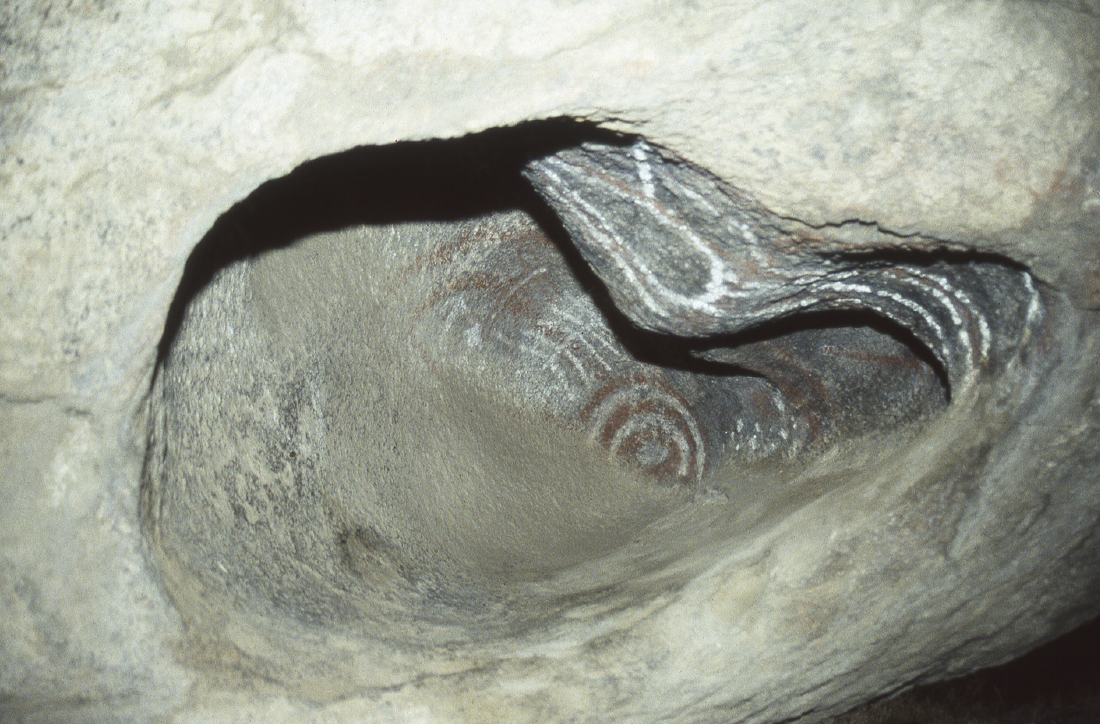
Figure 7. A “curing tunnel” at the Yokuts Rocky Hill site, south-central California. As this ritual is currently practiced, the patient crawls into the tunnel and lies flat while being smudged with burning sage and while songs are sung. The red and white concentric circle at the back represents the whirlwind, which carries spirits into the supernatural. Tunnel opening: about 1 m across at front. Figura 7. Un “túnel de curación” en el sitio yokuts de Rocky Hill, centro sur de California. En el ritual que se práctica actualmente, los pacientes gatean al interior del túnel y se acuestan mientras son impregnados con humo de salvia y otros cantan canciones. El círculo concéntrico rojo y blanco en el fondo representa el torbellino que lleva los espíritus a lo sobrenatural. Apertura del túnel: cerca de 1 m en su parte frontal.
Colorado River
The Colorado River corridor, the eastern boundary of the Californian culture area, was occupied by Yuman-speaking tribes (Mojave and Quechan). A key difference between these Yuman-speakers and other Californian tribes concerns the relationship between religious beliefs and practices and mythology (Whitley 2000, 2014b). In southwestern and south-central California –as well as in the Great Basin, discussed below– there was no direct relationship between myth, ritual, and rock art (Kroeber 1907; Laird 1976; Hultkrantz 1987). This reflected the general fact that in this region religion and ritual emphasized the supernatural world of spirit helpers, along with demonstrations of uses of supernatural power. In great contrast, religion and ritual among the Colorado River tribes were fully linked to their mythology (Kroeber 1925), much like Judeo-Christian beliefs and practices. Rituals in the Colorado River corridor were re-enactments of mythic events and recitations of mythic cycles, like a Christian mass, for example, often conducted at the locations of mythic events (Bourke 1889; von Werlhof 2004).
The Colorado River tribes made rock art in three different contexts. Shamans were believed to receive their supernatural power when they re-experienced the mythic creation of the world, which occurred at Spirit Mountain, Avikwa’ame, home of the creator deity Matavilya (Kroeber 1925). A series of large, pecked petroglyph sites are located around the base of this mountain, reflecting its use by shamans for vision questing (Forde 1931) (fig. 8). The Spirit Mountain motifs are almost entirely complex geometric/entoptic forms. They were intended to represent the “essence” or “pattern” of the creation, not its mythic actors or sequence of events (which everyone already knew) (Deveraux 1957; Kroeber 1957). The origin myth, in other words, was depicted without figurative imagery, using entoptic patterns alone.
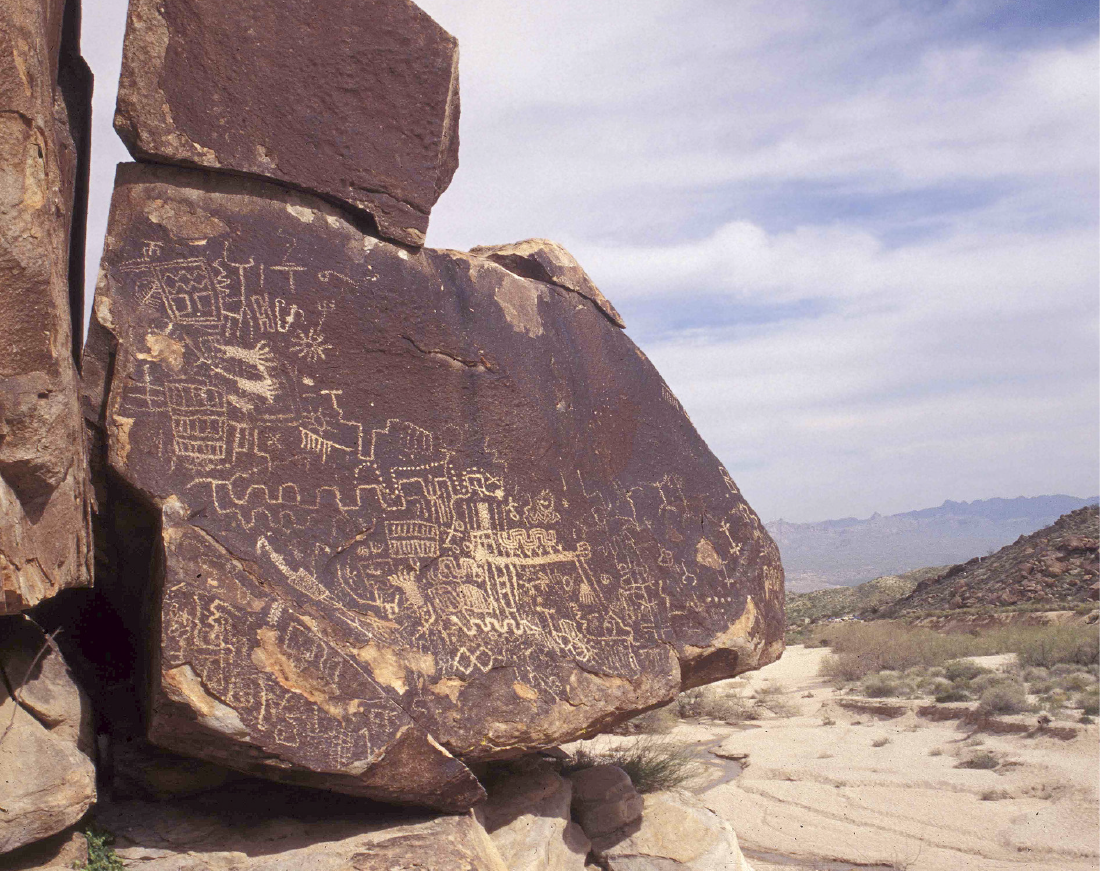
Figure 8. The Mojave Indian Grapevine site, in the Colorado River corridor of eastern California. This site is located at the foot of Spirit Mountain, the creation spot and home of the creator deity Matavilya. Mojave shamans had visions of the creation to achieve supernatural power. Instead of iconic imagery showing a narrative sequence of events, their art consists of complex geometric/entoptic images depicting the “pattern” or “essence” of the creation. Height of panel: about 2 m. Figura 8. El sitio indígena mojave de Grapevine, en el corredor del río Colorado del este de California. Este sitio está ubicado a los pies de la Spirit Mountain, el lugar de creación y hogar del dios creador Matavilya. Los chamanes mojave tenían visiones de la creación para obtener poder sobrenatural. En vez de representar imágenes icónicas mostrando una secuencia narrativa de eventos, su arte consiste en complejas figuras geométricas/entópticas representando el “patrón” o la “esencia” de la creación. Altura del panel: cerca de 2 m.
A second type of rock art, consisting of small and simple incised geometric/entoptic designs, was made by boys at the culmination of their puberty initiations (Whitley 2006) (fig. 9). These were conducted at the mythic location of the first such event. The ritual started with a long run across the desert on the “trail of dreams.” Part of the boys’ preparation for the initiation involved maintaining this trail by tamping it down, removing rocks, and sprinkling the edges with broken quartz so it could be easily followed at night. Their nasal septums were pierced once they reached the rock art site, which was necessary to become warriors and to eventually enter the land of the dead. The motifs the boys then created represent their “dreams” or asc experiences during the extreme exertion of the ritual run, which were thought to impart supernatural power (Bourke 1889; von Werlhof 2004; Whitley 2013).
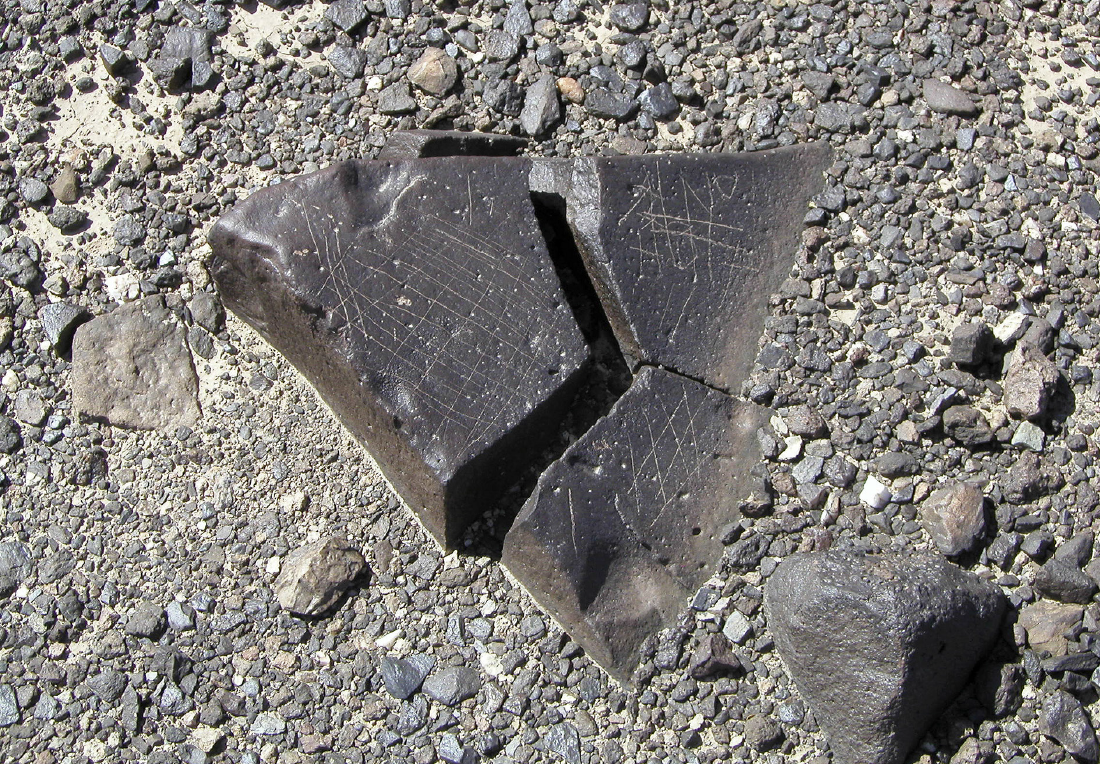
Figure 9. Boys in the Colorado River corridor also created incised rock art at the culmination of their puberty initiation, after running along the Trail of Dreams and having their nasal septums pierced. This occurred at the mythic location of the first such ritual. This site is now known as Indian Pass. Size of incised boulder: about 30 cm. Figura 9. Muchachos en el corredor del río Colorado también crearon arte rupestre grabado en la culminación de sus iniciaciones de pubertad, después de correr a lo largo del Trail of Dreams y tener sus tabiques nasales perforados. Esto ocurría en el lugar mítico del primer ritual de este tipo. Este sitio es ahora conocido como el Indian Pass. Tamaño de la roca incisa: cerca de 30 cm.
Colorado River tribes also made and used geoglyphs (intaglios). These were placed on the desert pavement on terraces above the river (fig. 10). They follow the mythic route culture-hero Mastamho traveled during his creation of the Colorado River Valley. The sites are at the locations of specific mythic events during Mastamho’s journey, and they depict the mythic actors and events appropriate to each spot (Bourke 1889; von Werlhof 2004). These commonly include Mastamho, sometimes his evil twin brother, or his mountain lion spirit helper, all rendered figuratively with the motifs having no tie to asc imagery. The sites were used for group pilgrimages, led by a shaman, intended to commemorate the creation and to spiritually cleanse the participants (von Werlhof 2004). The geoglyphs are, in a sense, analogous to the Catholic Stations of the Cross, on a landscape level. Dances and singing occurred at each location, also resulting in cleared dance circles and paths.
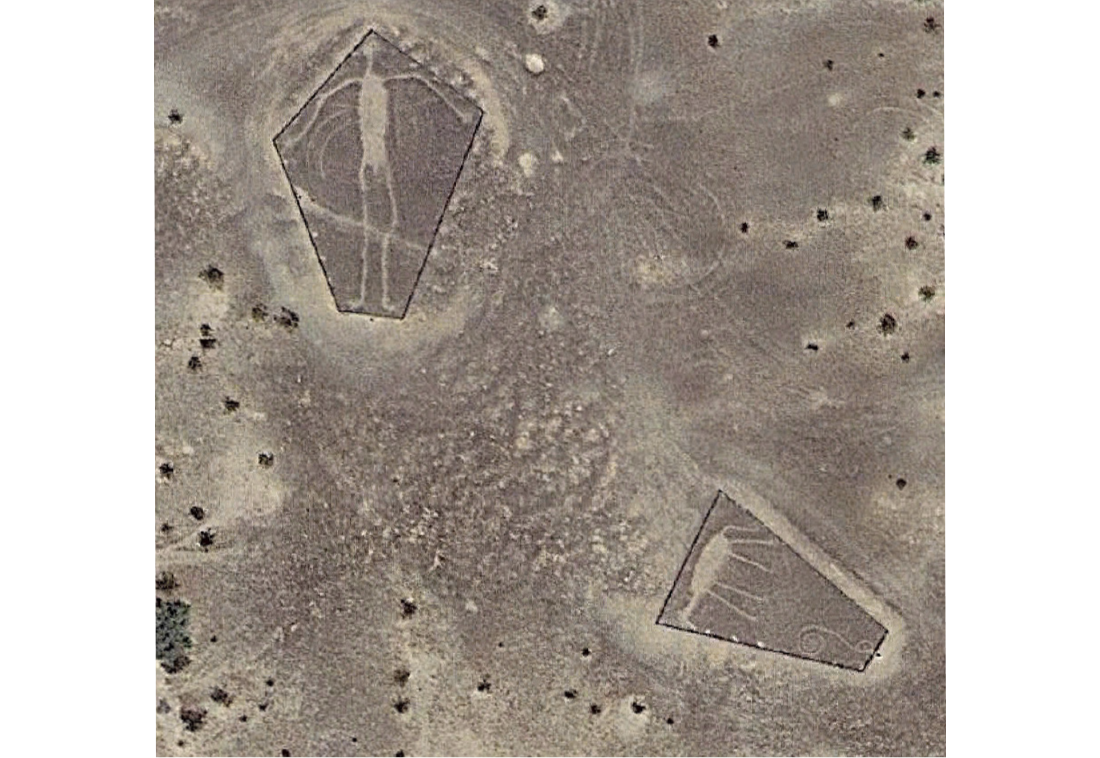
Figure 10. Yuman speaking tribes on the Colorado River corridor also made and used geoglyphs on the river terrace. They used these during a group pilgrimage, led by a shaman, that followed the path of the creation. Individual site locations were spots where specific mythic events had occurred, with the imagery portraying the mythic actors involved at that location. This site, the Blythe Geoglyphs, shows their culture hero, Mastamho, and his mountain lion spirit helper; both intaglios are now surrounded by fences to prevent damage. Length of anthropomorph geoglyph: about 60 m (photo by Harry Casey). Figura 10. Las tribus de la lengua yuman, en el corredor del río Colorado, también hicieron y usaron geoglifos en la terraza del río. Los utilizaron durante un peregrinaje colectivo, liderado por un chamán que seguía el sendero de la creación. Puntos específicos en el sitio fueron lugares donde eventos míticos particulares habían ocurrido, con las imágenes representando a los actores míticos involucrados en cada punto. Este sitio, los Blythe Geoglyphs, muestra a su héroe cultural, Mastamho, y a su ayudante espiritual que era un puma. Ambos geoglifos están hoy rodeados de vallas para prevenir el daño. Longitud del geoglifo antropomorfo: cerca de 60 m (fotografía de Harry Casey).
The Colorado River tribes thus created and used three distinct “styles” of shamanistic rock art. These varied in terms of technique, content, authorship, and association with asc, yet they were linked by their shared relationship to the mythic past. These three styles represent art created by different social groups, used for varying ritual functions, but all by the same culture and during the same time period. Style or technique alone then may not be indicative of culture or time period of creation, as many rock art researchers often assume.
GREAT BASIN ROCK ART
The Great Basin covers all of the state of Nevada, a large portion of Utah, the northeastern edge of California, and peripheral parts of Oregon and Idaho. This large desert region was occupied by Numic-speakers: the Paiute and Shoshone peoples. Despite very low population densities and minimal social structure (limited to patrilineal bands), the Numic created significant quantities of rock art. This includes perhaps the largest concentration of rock art in North America: the Coso Range, in eastern California. Great Basin rock art primarily consists of pecked petroglyphs predominated by three motif categories: geometric/entoptic designs, almost everywhere the most common motifs; anthropomorphs, including elaborately rendered patterned-body anthropomorphs; and quadrupeds, typically bighorn sheep (Ovis canadensis).
The origin and primary meaning of Great Basin rock art is similar in many respects to the pictographs of south-central California, located immediately to the west (Whitley 1992, 1994b, 1998, 2000; Whitley et al. 1999). Great Basin petroglyphs were made by shamans at the end of their vision quests to portray their visionary experiences and the spirit helpers they received (Laird 1976, 1984; Brooks et al. 1979; Shimkin 1986;(2) Hultkrantz 1987; Carroll 2007). Although the goal of the Great Basin vision quest typically was to acquire generalized curing power, certain locations were occupied by spirits who could imbue a supplicant with special kinds of supernatural potency. Prospective shamans traveled long distances to these places to obtain these specific powers (Driver 1937; Zigmond 1977, 1986; Brooks et al. 1979). One historic shaman, for example, is known to have come to the Coso Range from Utah, a distance of about 1,000 km, for his visionary experiences (Brooks et al. 1979). Great Basin rock art sites were then not owned by individual shamans or shamanic lineages, in contrast to south-central California. Additionally, the motif assemblages at certain sites and areas tend to emphasize specific motifs, representing a kind of (shamanic) functional specialization in the sites.
The sites in general terms were considered locations of revelation and places with concentrated supernatural power (Liljeblad 1986; Shimkin 1986; Hultkrantz 1987; Fowler 1992). The most powerful such spots on the landscape were springs and pools, where spirits commonly resided. Villages also typically occur at springs, further contributing to the potency of these locations because congregations of people concentrated power (Miller 1983). Rock art sites are then sometimes associated with villages. Although the Great Basin vision quest was a private activity, the villages were invariably only occupied seasonally, allowing for easy scheduling of “secret” rituals during the summer when village populations were dispersed. As ethnographers have documented, the Numic thought that the petroglyphs were constantly being made, and the sites were said to look different at every viewing (Zigmond 1977). Although the art is often located at “public places,” it was still created in clandestine, private ceremonies.
The Coso Range has a corpus of motifs that is roughly estimated to number in the millions; there are literally too many petroglyphs in this concentration of sites (covering approximately 300 km2) to count. Coso Hot Springs, considered the most supernaturally powerful spring in the Great Basin, is located in the Cosos, contributing to the general sacredness of this location (Brooks et al. 1979). Although, again, all kinds of shamanic powers could be obtained in the Cosos, these mountains were especially associated with rain shamanism, as indicated in the ethnographic record (Kroeber 1925; Steward 1933; Driver 1937; Voegelin 1938; Kelly 1939; Gayton 1948; Zigmond 1977, 1986). This is also illustrated iconographically in the petroglyphs, in three ways. First, so-called patterned-body anthropomorphs depict shamans in their supernatural power form, partly transformed into their spirit helpers, wearing their ritual shirts painted with their individual signs of power (Kelly 1932; Opler 1940) –entoptic images they had seen in their asc and while carrying their ceremonial paraphernalia. Figure 11, for example, shows an anthropomorph with bird talon feet and a bow and arrows –used ritually by shamans to call the rain (Kelly 1939). The figure also wears a quail topknot feather headdress, the special headdress of rain shamans (Kelly 1936). This petroglyph depicts a specific rain shaman who also had a bird spirit helper.

Figure 11. These “patterned body anthropomorphs” are self-portraits of individual shamans transformed into their supernatural power forms, wearing the ritual tunics that were painted with their signs of power (the geometric/entoptic images they had seen in their vision quests). The large central figure has a quail topknot feather headdress, a special ritual headdress of rain shamans. He is carrying a bow and arrows, used in the rain-making ritual. The concentric circle face is the whirlwind, which carried spirits into the supernatural. Height of central anthropomorph: about 1 m. Figura 11. Estos “antropomorfos con el cuerpo estampado” son autorretratos de chamanes individuales transformados en sus formas de poder sobrenatural, usando las túnicas rituales pintadas con sus signos de poder (las imágenes geométricas/entópticas que vieron en sus búsquedas visionarias). La figura central alargada tiene un tocado de plumas con moño de codorniz, tocado ritual especial de los chamanes de la lluvia. Lleva un arco y flechas, usados en el ritual para provocar la lluvia. Su rostro de círculo concéntrico es el torbellino, que conduce espíritus a lo sobrenatural. Altura del antropomorfo central: cerca de 1 m.
The Coso corpus, second, is renowned for its large quantity of bighorn sheep engravings. Bighorns were widely associated with rain and stormy weather in the Far West (Mathews 1902; Spier 1930; Drucker 1941; Turney-High 1941; Reichard 1950; Alvarez 1983), likely because of a natural model: their characteristic herd movements immediately before rain allowed them to exploit quickly-sprouting desert plants, and people with detailed knowledge of bighorns can predict the rain based on these movements. As the ethnography demonstrates, bighorn spirit helpers gave rain making power (Kelly 1936, 1939; Laird 1976), accounting for the high proportion of bighorn motifs in the Cosos. But the iconography provides further support for the ethnography. Figure 12 is a Coso bighorn motif with four important iconographic attributes. The large incurving horns indicate that this is an adult male bighorn, not a female or immature male. The flat, plantigrade feet rather than hooves indicate that this is a therianthrope –a human transformed into a spirit helper– rather than a “natural” or realistic depiction: it is a shaman transformed into his bighorn spirit helper, in other words. And there is also an arrow or spear sticking out its back, while the bighorn has a small, upraised tail.
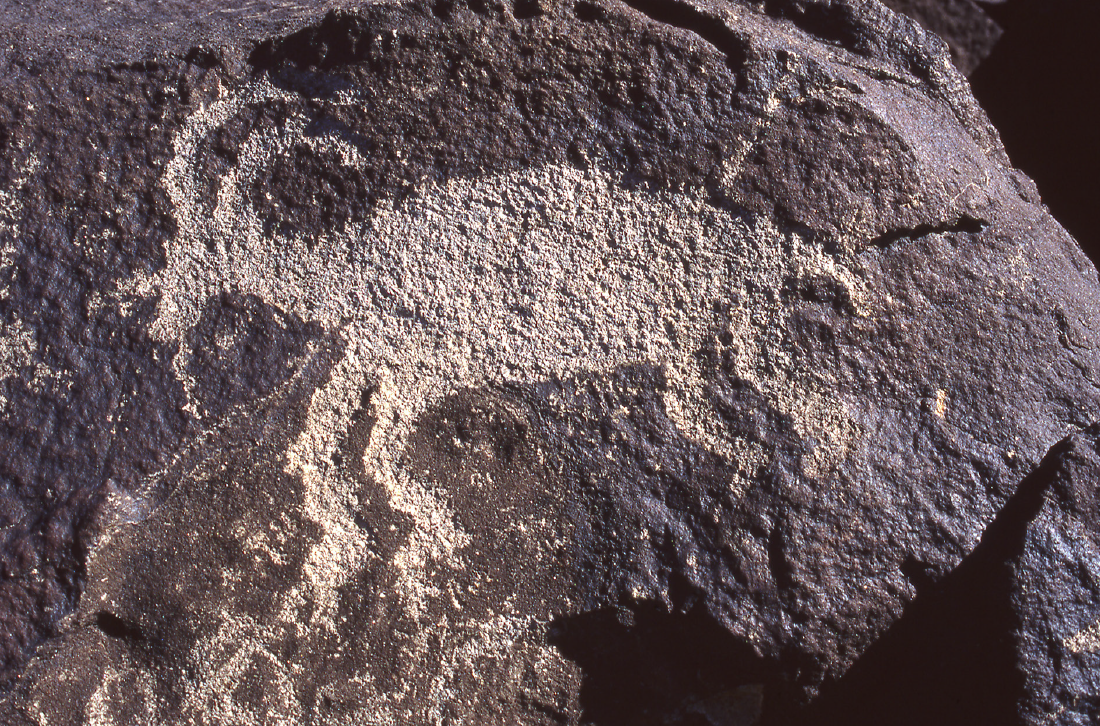
Figure 12. Killed bighorn sheep motif, Coso Range. Note the flat plantigrade feet, indicating that this is a human partly transformed into a sheep. Length of sheep: about 75 cm. Figura 12. Motivo de un carnero cimarrón matado, Coso Range. Nótense los pies planos plantígrados, indicando que es un humano parcialmente transformado en un carnero. Longitud del carnero, cerca de 75 cm.
These last two details tie this motif to panels depicting “hunters and sheep,” as in figure 13. Based on panels like these, many archaeologists, ignoring the ethnography, interpreted the Coso petroglyphs as evidence of sympathetic hunting magic, with the Coso corpus then argued to result from a bighorn sheep hunting cult (Heizer & Baumhoff 1959, 1962; Grant 1968); however, the ethnography indicates that there was no such hunting cult, bighorn racks were not used as hunting disguises (Steward 1941, 1943; Fowler 1989), and sympathetic magic was not employed to hunt these animals. In contrast, the shamanic use of hunting magic to acquire antelope is well described in the Great Basin ethnographic literature (Park 1938; Keyser & Whitley 2006), but there are no depictions of antelope to my knowledge in the rock art. The Coso Range, which has the largest concentration of bighorn motifs, in fact, was at best always a marginal environment for these animals and there is no evidence in the faunal record, from any time period, to suggest that bighorns were ever an emphasis of hunting (Whitley 1994b). Why then the focus on hunted and killed bighorns in the art?
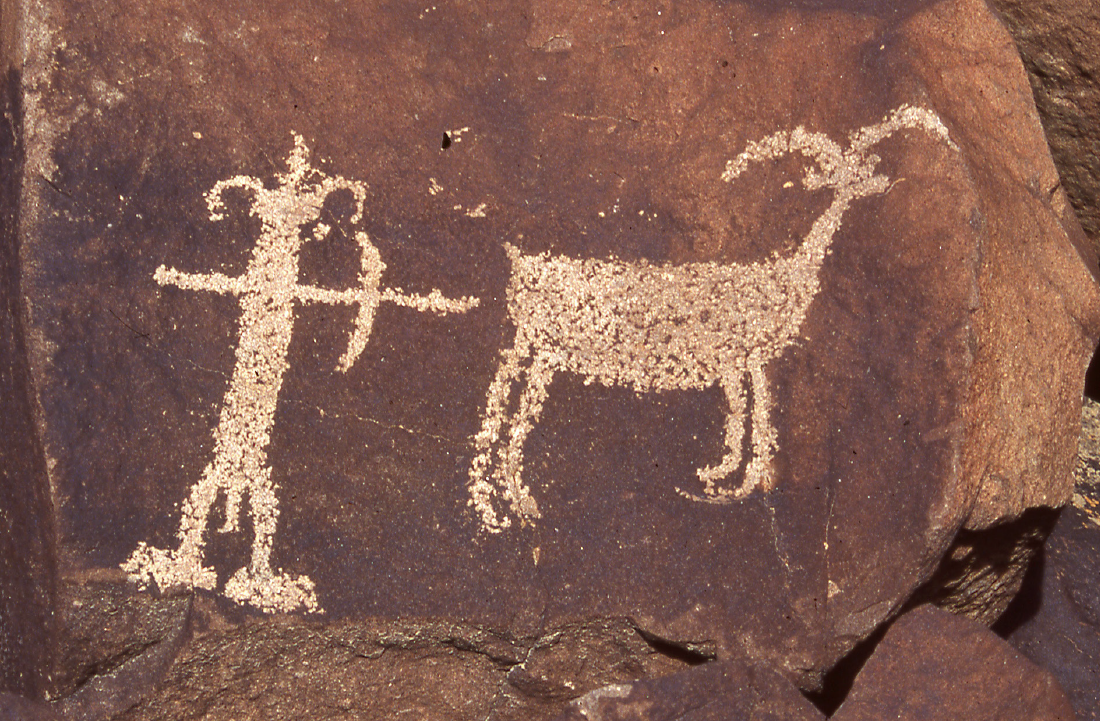
Figure 13. Hunter and sheep scene, Coso Range. “Killing a bighorn” was a metaphor for making rain. The anthropomorph shown here is depicted as partly transformed into a bighorn, emphasizing that this is a shaman “killing himself,” or entering a trance. Height of anthropomorph: about 50 cm. Figura 13. Escena de cazador y carnero, Coso Range. “Matar a un carnero cimarrón” era una metáfora para provocar la lluvia. El antropomorfo mostrado aquí se representa parcialmente transformado en un cimarrón, enfatizando que este es un chamán que “se mata a sí mismo” o está entrando en un trance. Altura del antropomorfo: cerca de 50 cm.
The answer is provided by an ethnographic comment, when ontologically contextualized and interpreted: “It is said that rain falls when a mountain sheep [bighorn] is killed […]. Because of this some mountain sheep dreamers [shamans] thought they were rain doctors [shamans]” (Kelly 1936: 139).
As noted above, “death” and “killing” were metaphors for a shaman’s entry into trance (Kroeber 1907; Gayton 1948; Zigmond 1977, 1980; Whitley 1994a, 2008). This reflects a common shamanistic metaphor for an asc, based on a natural model for a trance experience: the loss of consciousness, immobility, and grief or fear that occur in some asc. It further reflects the fact, noted above, that shamans’ asc were not necessarily ecstatic but instead were often more like nightmares. A shaman made rain by manipulating supernatural power in a visionary experience; his entry into this state was his “death.” Much like Christian symbolism and belief, where Christ’s death created eternal life, Great Basin rain shamans “killed” themselves spiritually, to control the weather and ensure the success of their band.
The therianthrope in figure 12 is thus pierced by the spear/arrow, a fact emphasized by its small, upraised tail (included on effectively all bighorn motifs): a tail posture associated with death (Whitley 2020). Figure 13 includes some of these same iconographic details and metaphoric references. The male anthropomorph is partly transformed into a bighorn, as shown by the bighorn rack with a vertical appendage, presumably a feather but regardless a sign of supernatural power and an indication that this is not, somehow, a hunting disguise. The anthropomorph is shooting a bighorn that, again, has the upraised tail posture of death: it is already dead. This is not a hunting scene but instead a symbolic act of killing and dying: a metaphoric representation of a shaman entering the supernatural to become his spirit helper and manipulating the resulting power to make rain.
The Paiute and Shoshone peoples of the Great Basin have often been viewed by anthropology as exemplary of the base-level stage of human social evolution, with a culture that was primarily “gastric” in nature and that lacked significant ritual and symbolism (Steward 1955). Foundational to this interpretation is an implicit and unstated belief about their supposed primitive mentality, as if people with simple material culture living in small-scale societies necessarily were less cognitively sophisticated than contemporary Westerners, and could only think about food. But this is racism, conscious or not, rather than a scientifically- and empirically-informed understanding of human cultural diversity and our innate mental characteristics. As the Great Basin case illustrates, there is every reason to assume that hunter-gatherer shamanistic rock art involved symbolism as complex as our own.
COLUMBIA-FRASER PLATEAU
The Columbia-Fraser Plateau is a large basalt highland that covers parts of the states of Oregon, Washington, and Idaho and extends north into interior British Columbia and Canada and south into northeastern California. The Columbia River cuts through the plateau and is its major drainage. It and other rivers served as a major focus of Native American occupation, which was predominantly occupied by Salishan (e.g., Okanagan) and Sahaptian (e.g., Nez Perce) speakers. The rivers had important yearly salmon runs resulting in tribal groups that greatly augmented hunting-gathering with fishing, even in the interior portions of the plateau.
Plateau rock art includes petroglyphs and pictographs made by all members of society, in at least six ritual contexts (Keyser & Whitley 2000, 2006; Keyser & Taylor 2002; Keyser et al. 2004; Whitley et al. 2004; Hann et al. 2010). Boys and girls were sent on individual vision quests when they came of age by their parents (Teit 1896, 1930, n.d.; Hill-Tout 1978; York et al. 1993). This involved isolation, fasting, and physical exertion which, in combination, would result in a dream or asc. The simple geometric/entoptic images that resulted were painted or engraved at their vision quest location, and were understood to represent their acquisition of a spirit helper which would assist them throughout their lives. Adults of both sexes also occasionally made similar rock art during life crises, such as the death of a spouse (Cline 1938) (fig. 14). This served to reconnect them to their spirit helpers and reinvigorate their power. Warriors documenting status acquisition through war honors sometimes made rock art as well, and it was apparently also created during certain mortuary rituals, although we currently have few details on this function (Hann et al. 2010).
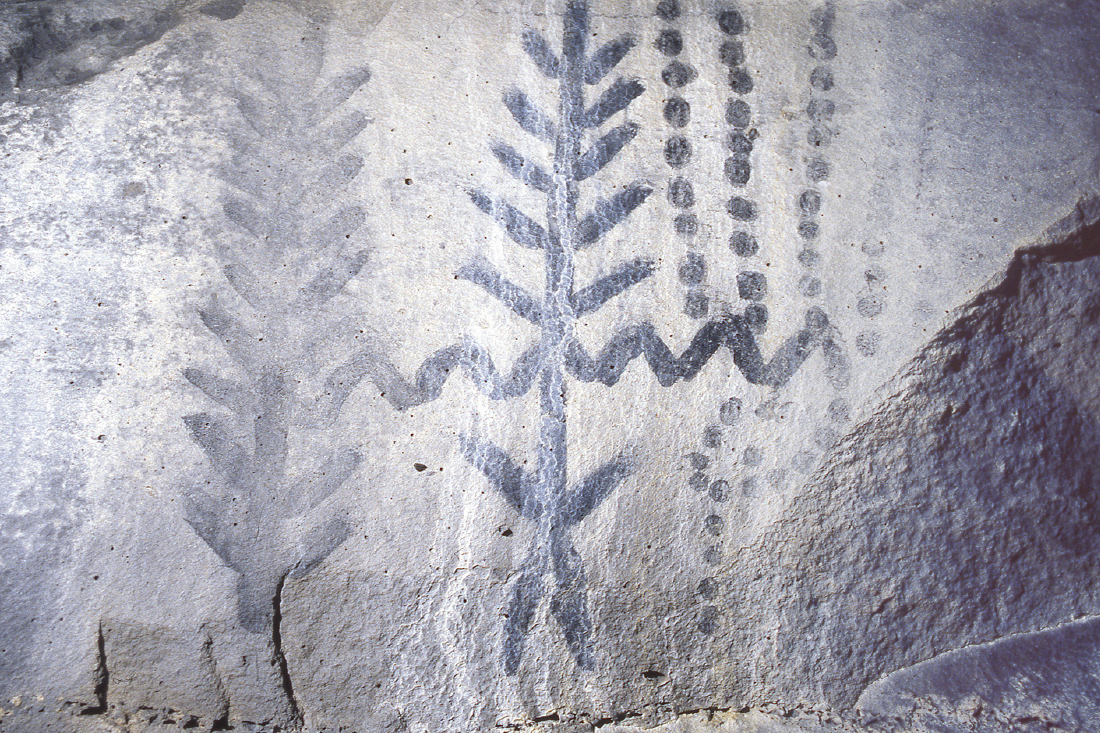
Figure 14. Rock art was made in a number of contexts by different members and age groups of society on the Columbia-Fraser Plateau. This example, from the Symbol Bridge site in northeasternmost California, is believed to have been made by puberty initiates or adults during life crises during their individual vision quests to acquire or restore their supernatural power. Dots are fingerprints indicating size of panel. Figura 14. El arte rupestre fue hecho en una serie de contextos por diferentes miembros y grupos etarios de la sociedad en la meseta de Columbia-Fraser. Este ejemplo, del sitio Symbol Bridge, en la zona más al noreste de California, se cree que fue hecho por iniciados en la pubertad o adultos durante crisis de vida en sus búsquedas visionarias individuales, para adquirir o restaurar su poder sobrenatural. Los puntos son huellas dactilares indicando el tamaño del panel.
Shamans made rock art at the culmination of their vision quests to document their acquisition of spirit helpers and to manipulate the resulting power, for a variety of purposes (Ranck 1926; Spier 1930; Hines 1992, 1993; Hann et al. 2010) (fig. 15). As in other regions in Far Western North America, generalized curing power was the primary but not exclusive goal. One account indicates that shamans intentionally placed their painted or engraved motifs in difficult to reach locations which “adds to their mystery” (Hill-Tout 1978: v48), explaining why motifs are sometimes located in high, almost inaccessible spots.

Figure 15. Columbia-Fraser Plateau shamans also made rock art, in this case engravings, to portray their acquisition of spirit helpers during their vision quests. This particular motif, at Gingko State Park, Washington, shows two anthropomorphs under rayed arcs. As a frequently depicted motif, it may represent the acquisition of a mythic actor as a spirit helper. Length of anthropomorphs: about 40 cm. Figura 15. Los chamanes de la meseta de Columbia-Fraser también hicieron arte rupestre, en este caso grabados, para representar su adquisición de espíritus ayudantes durante sus búsquedas visionarias. Este motivo en particular, en el Gingko State Park, Washington, muestra dos antropomorfos debajo de arcos con rayos. Como es un motivo frecuente, puede representar la adquisición de un actor mítico como un espíritu ayudante. Longitud de los antropomorfos: cerca de 40 cm.
The relationship between ritual, vision questing and mythology among the Plateau tribes, furthermore, differed from other regions in the Far West: the relationship was fluid rather than rigid, unlike the Californian and Great Basin culture areas. Rock art sites then could be but were not invariably mythic locations, and mythic actors potentially could be but were not always spirit helpers (Whitley et al. 2004; David 2010). An additional distinctive aspect of Plateau rock art warrants mention: sympathetic hunting magic (Keyser & Whitley 2006). Although widely assumed to explain much rock art globally, sympathetic hunting magic has almost invariably been undefined and (as noted above) has been based on beliefs about the supposed primitive mentalities of Indigenous peoples more than any real evidence or analysis. Understanding this practice requires clarification of what sympathetic magic is, and how it differs from religion more generally.
Magic is an action undertaken in the real world using supernatural powers to cause a reaction in that same real world. Religion, in contrast, involves practices in the real world intended to influence the supernatural. Religion invariably requires negotiation: religious actions, such as appealing to a spirit or deity, may ultimately be intended to have a real-world effect but this is always indirect. In contrast, two types of magic that are believed to have direct real-world impacts are typically recognized: contagious magic, where physical contact can cause future influences even at a distance, and sympathetic magic, where “like creates like” (Keyser & Whitley 2006).
A specific kind of sympathetic magic, sorcery, was in fact common in shamanistic rock art throughout Far Western North America. Figure 6, from south-central California, was described to me by a contemporary Yokuts informant as a shaman killing someone in an act of sorcery using magical “air-shot” (metaphorically an arrow) which injected a diseased object or poison into the victim. But there is no evidence for, and repeated ethnographic denials of, sympathetic hunting magic and rock art in the Californian and Great Basin culture areas. Multiple lines of evidence support this practice in the plateau, however. These include ethnographic descriptions of visions of hunting events involving magical enclosures used to capture game, provided by a game-animal spirit helper; the absence of a taboo against eating the species of an individual’s spirit helper (otherwise common among most hunter-gatherers); and the iconography of the art itself. This includes hunting scenes of multiple individuals with drive-lines/fences along with game animals (Keyser & Whitley 2006). The so-called hunting scenes in the other two culture areas, in contrast, consist of a single individual and animal, as in figure 13, denoting the acquisition or use of powers related at least metaphorically to hunting, but not sympathetic hunting magic, per se (Keyser & Whitley 2006).
CONCLUSIONS
There are some implications of the ethnographic record of Far Western North American shamanistic rock art that warrant emphasis, some of which may be relevant to South-American rock art research. The ethnography highlights the wide variety of origins, functions, and meanings of this art and the many social groups that were responsible for its creation. Far from a monolithic interpretation, shamanism should be understood as a context within which the art can be analyzed and interpreted, not a final interpretation of its meaning. One characteristic of shamanistic rock art, however, is widespread if not truly universal among cultures with shamanistic religions. This is its relationship to the acquisition and manipulation of supernatural power.
The ethnography also demonstrates the inadequacy of standard stylistic analyses in much rock art research. Too often so-called rock art styles are simply descriptive categories created by the archaeologist where the significance (in terms of age, archaeological culture and function) is assumed but never analyzed or demonstrated. As has been emphasized above, different social groups can create very different styles of rock art for diverse reasons during a single time-period. Descriptive rock art styles should be recognized as starting points for analysis but not conclusions of a research study.
It is also clear that the relationship of rock art to myth varied widely, even between immediately adjacent tribal groups, like the Great Basin Numic speakers and the Colorado River Yuman speakers. Shamanistic rock art certainly could be linked to mythology but the assumption that rock art necessarily portrays mythic actors and events without supporting evidence of some kind reflects a transposition of Judeo-Christian religious beliefs onto non-Western cultures. Mythic rock art, furthermore, can be entirely non-figurative in nature and need not necessarily portray actors and narrative events. The depiction of the creation by Yuman shamans is an example with their geometric/entoptic motifs representing the essence or pattern of this singular event, not its sequence of events and the personalities involved. At the same time their geoglyphs were exactly intended to portray the mythic actors and sequence of mythic events, where these were believed to occur, in iconic or representational form.
A primary clue to the relationship of rock art and mythology, at least for the relatively recent past, is in regional ethnography and what it implies about the relationship of myth and ritual. If ritual largely replicates mythic events or invokes mythic actors and events, we can expect that the rock art might also have that relationship. Alternatively, should there be a separation between the two, as in much of Native California, it is unlikely that rock art would illustrate mythology.
I have in the above described the different origins and primary meanings of Far Western North American rock art, but I have also emphasized that symbols always have multiple meanings, beyond the ones identified here. It is useful to conclude by stressing the importance of the social (as opposed to religious) meanings of hunter-gatherer rock art, and what this can tell us about the past. Two examples highlight the potential social implications of this art. The Chumash pictographs of south-central California, first, represent visions of the supernatural, referred to ethnographically as “dreams.” Such dreaming power was required for success in all aspects of life, beyond religion alone, including politics, hunting and economic wealth (Bean 1975). It follows that the distribution of rock art sites on the landscape reflects not just the distribution of shamans but also the distribution of politico-economic power among these peoples. An examination of this distribution shows that rock art sites were initially clustered into just a few concentrations, each with equally significant concentrations of large village sites. This distribution changes over time, however, documenting a population collapse in the inland Chumash region associated with the Medieval Climatic Anomaly. This occurred at the same time as population increased on the coast, suggesting a movement of the inland population along with a shift in political power to the coastal region. Rock art in this case charts not only changing power relationships but the rise of the coastal Chumash chiefdoms too (Whitley & Whitley 2012).
A second example is provided by the Coso Range petroglyphs in the Great Basin. With the onset of the Medieval Climatic Anomaly, circa 1500 years ago, adaptation shifted from wide ranging foraging, including large mammal hunting, to an intensification in plant gathering of seeds and nuts. During this same transition there was an increase in the production of bighorn sheep, hunters shooting sheep, and elaborate patterned-body anthropomorph petroglyphs, all associated with rain-making shamanism. The importance of hunting, an exclusively male activity, was then diminished in terms of diet in favor of gathered plant resources, a female task, yet the rock art increasingly emphasized males and their activities and especially males’ importance in rain-making, which was essential in the increasingly dry climate to female plant gathering success. This adaptive shift and the related change in the emphasis in petroglyph production marked the rise of patrilineal bands and band headmen (Whitley 1994b), who were almost invariably also shamans (Laird 1976, 1982). Rock art in this example served an ideological function related to gender relations in society, helping to support the importance of males during a period when their contributions to social well-being were less and less important (Whitley 1994b).
Shamanistic hunter-gatherer rock art then potentially has a variety of origins and creators, and it can mean many things, beyond just its general connection to visionary experiences and supernatural power. Though this connection is important, it is especially useful to look beyond it alone to better understand the hunter-gatherer past.
Aginsky, B. 1943. Culture Element Distributions: xxiv, Central Sierra. Anthropological Records 8 (4): 393-468.
Alvarez, A. 1983. Cocopa. In Handbook of North American Indians, A. Ortiz, ed., vol. 10: Southwest, pp. 99-112. Washington dc: Smithsonian Institution.
Applegate, R. 1978. Atishwin: The Dream-Helper in South-Central California. Socorro: Ballena Press.
Bean, L. 1975. Power and Its Application in Native California. In Native Californians: A Theoretical Retrospective, L. Bean & T. Blackburn, eds., pp. 407-420. Socorro: Ballena Press.
Bourke, J. 1889. Notes on the Cosmogony and Theogony of the Mojave Indians of the Rio Colorado, Arizona. Journal of American Folklore 2 (4): 169-189.




